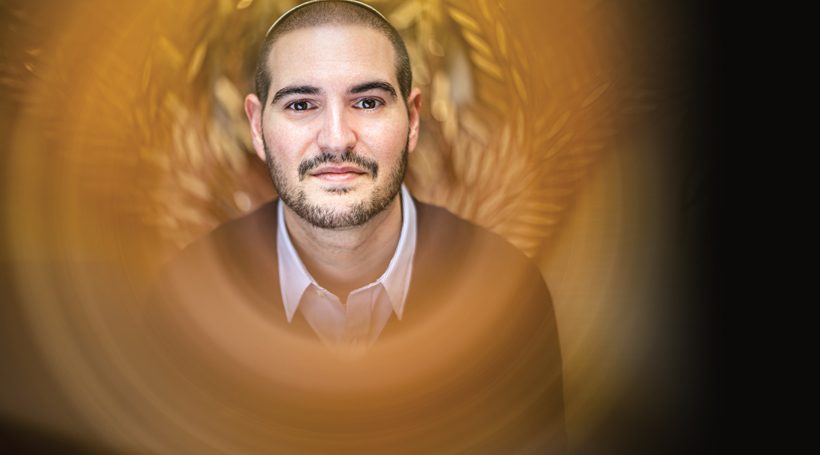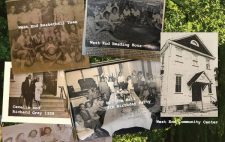For years, Rabbi Michael Perice had a dark secret. He was in recovery for an opioid addiction. Perice didn’t know how his congregants would react to his story, but decided the time had come to take a leap of faith and shine light on his painful past.
“I always begin like this,” says Michael Perice. “My story was innocent, and it was tragic.”
In 2007, when Perice was a student at Temple University and living in Cherry Hill, he was stopped at a red light on Springdale Road when the driver behind him, talking on a cell phone, slammed into the back of his car.
“I did what they say you should never do, which is brace for impact,” Perice says. “I tensed up my whole body. I had whiplash, a shoulder issue and this dislocated disk in my lower back which caused horrible sciatic nerve pain down my leg. I’d wake up in the middle of the night feeling like someone was ripping my muscles apart. My pain was real.”
Of course, Perice sought the help of doctors to deal with his pain.
“Ten or 15 years ago, we did not know what we know today,” he says. “The pharmaceutical companies lied to doctors and told them the pills were not addictive. I was one of the people where the first order of business was a prescription for Vicodin. I quickly found out that pain medicine is ironic: It only masks the pain, and then intensifies it when you’re coming off the meds.”
In more pain than ever, Perice just kept returning for more medicine. “It’s like this cycle where I’m taking more and more and running out of my prescriptions faster and faster. The pain is intensifying. Eventually my doctor is like, whoa, we can’t keep giving you pain meds, and by this point I’m firmly addicted.”
The next few years were a blur of pain and pills, but eventually he got help and got clean. It was a chapter of his life he thought was closed, until last year when Perice – now Rabbi Michael Perice of Temple Sinai in Cinnaminson – decided to tell his congregants the whole story. Going public about his struggles with addiction was no small thing, especially for a man in his position, but Perice knows it was exactly the right thing to do.
For a while after the accident, Perice says, he bounced between doctors, getting new prescriptions. “Eventually you can’t find doctors,” he says. “It’s so hard for people to understand, but I never had a drug dealer. It wasn’t like that. You’d go to friends or friends of friends, and it was never so organized that you thought about it as doing something wrong. You don’t think of it as a recreational thing; you’re not taking it to get high, you’re taking it to get back to normal.” At the peak of his addiction, Perice says he was taking between 80 and 100 milligrams of OxyContin every day.
“That’s probably like $60 to $80,” he says. “To come up with that every day is a herculean effort. You sell things, you borrow money. You learn to be deceptive. But eventually, everyone hits ‘the wall.’ You’ve borrowed every dollar you can, you’ve told every lie you can tell. You don’t know what to do, you don’t know who to tell, and you don’t reasonably think you’re doing the right thing anymore. You know it’s wrong but you’re too deep in it. You go through your contact list and nobody picks up, you start into withdrawal, and it’s horrible. You want to rip your skin off your body. You have the flu times a million.”
That’s exactly where Perice was in the spring of 2011.
“I call up a friend of mine who’s no longer alive, and I say, ‘dude I’m in a really bad situation. I need anything.’ He’s like, ‘I got you, I’ll be over.’ Three excruciating hours later, I get a knock on the door,” Perice recalls. “He’s like here you go, love you, peace. I look down and in my hand is a bag of heroin.”
Then, Perice’s story took a turn – and not one for the worse. It’s something he now sees as a watershed moment in his life.
“I was not a religious person at the time,” he says. “I was a secular Jew from the ages of 13 to 25. And I remember being really angry at God during this withdrawal. I’ve told this story now a hundred times, and every time I struggle with how to tell what happens next.”
Perice walked down the hall to his bathroom, carrying the tiny bag of heroin that he remembers had a picture of The Hulk printed on it.
“I’m violently sick, and here in the palm of my hand is the thing that will ‘cure’ it,” he says. “I have this moment of calm wash over me, and I can sense the power of it. I was able to see with very clear eyes that if I did this I was going to die. And then, I flushed the drugs.”
Instead of taking heroin, Perice called his parents to tell them he needed rescuing. They were shocked, he says, but willing to get him the help he needed.
“The stigma of addiction was so bad then, I refused to go to any type of inpatient rehab, because I was so convinced it would ruin my life,” he says. “My family got me in to see this doctor who specializes in addiction and outpatient treatment. He told me there are medications that could save my life. It helped me rebuild my life and deal with my actual pain.”
All the while, Perice was remembering that moment in the bathroom.
“That was a higher power moment for me. I couldn’t explain it, and I knew it was something I wanted to explore,” he says. “And when I started to rebuild my faith, I drew a direct connection to that moment.”
Perice was working at his family’s funeral home, and began seeing rabbis at work and, he says, “rebuilding a connection with Judaism.”
In 2012, during a snowstorm, Perice had his next major moment of clarity. “All the funerals that weekend were cancelled except one: a man in his 90s who had one relative – a sister in a wheelchair,” he says. “It’s decided that she has to stay in the car, she can’t go to the graveside.”
While the service was happening in the cemetery, Perice climbed into the car with the mourning sister. “I asked her to tell me something about her brother. She turns to me and starts telling me all these stories. Then, she asked me to pray with her. I didn’t know many prayers. I only knew the mourner’s kaddish. We only typically say it at a graveside, or on the anniversary of a loved one’s death. It’s a prayer every Jew knows. But the look on her face was like I’d just given her the greatest gift I’d ever given anybody.”
Something had awakened in Perice, and soon he was in Israel working to strengthen his Hebrew before returning to attend rabbinical college in Philadelphia. He graduated in the summer of 2020 and was only in his position at Temple Sinai a short while when he decided it was time his flock got to really know him.
“I had this realization that every day my congregants come to me and share the most vulnerable parts of their lives,” he says. “I wanted to say to them: I trust you the way you trust me every day.”
Of course, it was still nerve-wracking.
“I’ve worked so hard to become a community leader, a respected person in the community,” he says. “You know the stigmas. We’ve come a long way, but not far enough. I was fearful, but I just had this conviction, this sense that I had to do it. I remember walking around my house saying ok, sometimes you just have to take a leap of faith.”
And coming from him, Perice realized, the story might actually help lift some of that stigma.
“Sometimes all it takes is one person,” he says. “I realized the weight of what my title would bring to this. We all have biases. If anybody was really being true with themselves and pictured in their mind who they think of as an addict, it’s the person on the street begging for money. But the truth is this is a pervasive issue that touches all races and classes. My story is the same as millions of Americans, but you put rabbi in front of it, and it brings down those walls.”
On a Zoom call with more than 80 temple members last summer, Perice told the whole story. His congregation listened and, for the most part, he says, understood and appreciated his candor. “I knew I wanted to share the story publicly, for many reasons,” he says. “If it being told could help save just one life, to me that made all the risk involved worth it.”
And it was worth it – not just for Perice and his flock, but also for families from far outside South Jersey who heard the story and recognized themselves in it.
“About a week later, I received hundreds of emails from families across the US,” he says. “But one stuck out. I received an email from a former congregant of my synagogue. She wrote that 4 years ago she and her husband lost their child to this disease. She said, ‘if someone like you had been there then, maybe my child would be here today.’ If I didn’t know before, I certainly did after that; we’re talking about life and death. The stigma keeps people from seeking treatment. There were a million reasons I wanted to do this, and I’m glad I did because the impact has been a beautiful, positive thing.”














